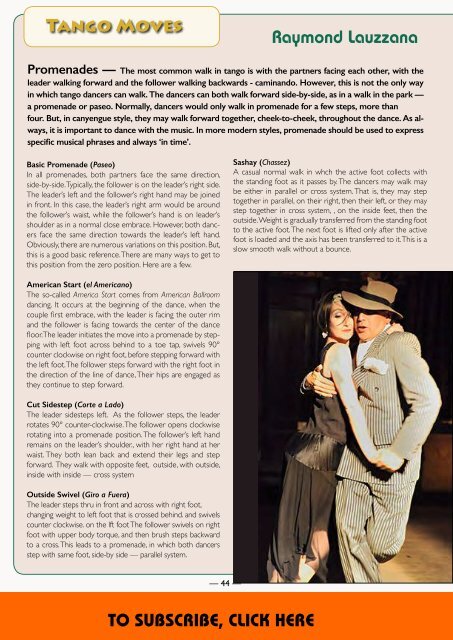Modern Tango World #7 (Havana & the Caribbean)
Caribbean Special Features Tango in the Crystal Isles Percell St. Thomas & Raymond Lauzzana 03 Tango Cubano Maria Roumpalou 08 Tango on the Costa Caribe Raymond Lauzzana 12 Cruising the Caribe Percell St. Thomass 14 Guide to Tango in the Caribbean 18 Cuba’s Special Painter Pedro Álvarez Castelló 24 Interview with Martin Delgado Marco Buso 28 Top Ten Ways to Get Asked to Dance Karen Kaye 32 100 Years of Recorded Tango Raymond Lauzzana 34 New Tango Music Arndt Büssing 38 Tango Moves: Promenades (Paseos) Raymond Lauzzana 42 Letters to the Editor 46
Caribbean Special Features
Tango in the Crystal Isles Percell St. Thomas & Raymond Lauzzana 03
Tango Cubano Maria Roumpalou 08
Tango on the Costa Caribe Raymond Lauzzana 12
Cruising the Caribe Percell St. Thomass 14
Guide to Tango in the Caribbean 18
Cuba’s Special Painter Pedro Álvarez Castelló 24
Interview with Martin Delgado Marco Buso 28
Top Ten Ways to Get Asked to Dance Karen Kaye 32
100 Years of Recorded Tango Raymond Lauzzana 34
New Tango Music Arndt Büssing 38
Tango Moves: Promenades (Paseos) Raymond Lauzzana 42
Letters to the Editor 46
You also want an ePaper? Increase the reach of your titles
YUMPU automatically turns print PDFs into web optimized ePapers that Google loves.
<strong>Tango</strong> Moves<br />
Raymond Lauzzana<br />
Promenades — The most common walk in tango is with <strong>the</strong> partners facing each o<strong>the</strong>r, with <strong>the</strong><br />
leader walking forward and <strong>the</strong> follower walking backwards - caminando. However, this is not <strong>the</strong> only way<br />
in which tango dancers can walk. The dancers can both walk forward side-by-side, as in a walk in <strong>the</strong> park —<br />
a promenade or paseo. Normally, dancers would only walk in promenade for a few steps, more than<br />
four. But, in canyengue style, <strong>the</strong>y may walk forward toge<strong>the</strong>r, cheek-to-cheek, throughout <strong>the</strong> dance. As always,<br />
it is important to dance with <strong>the</strong> music. In more modern styles, promenade should be used to express<br />
specific musical phrases and always ‘in time’.<br />
Basic Promenade (Paseo)<br />
In all promenades, both partners face <strong>the</strong> same direction,<br />
side-by-side. Typically, <strong>the</strong> follower is on <strong>the</strong> leader’s right side.<br />
The leader’s left and <strong>the</strong> follower’s right hand may be joined<br />
in front. In this case, <strong>the</strong> leader’s right arm would be around<br />
<strong>the</strong> follower’s waist, while <strong>the</strong> follower’s hand is on leader’s<br />
shoulder as in a normal close embrace. However, both dancers<br />
face <strong>the</strong> same direction towards <strong>the</strong> leader’s left hand.<br />
Obviously, <strong>the</strong>re are numerous variations on this position. But,<br />
this is a good basic reference. There are many ways to get to<br />
this position from <strong>the</strong> zero position. Here are a few.<br />
Sashay (Chassez)<br />
A casual normal walk in whch <strong>the</strong> active foot collects with<br />
<strong>the</strong> standing foot as it passes by. The dancers may walk may<br />
be ei<strong>the</strong>r in parallel or cross system. That is, <strong>the</strong>y may step<br />
toge<strong>the</strong>r in parallel, on <strong>the</strong>ir right, <strong>the</strong>n <strong>the</strong>ir left, or <strong>the</strong>y may<br />
step toge<strong>the</strong>r in cross system, , on <strong>the</strong> inside feet, <strong>the</strong>n <strong>the</strong><br />
outside. Weight is gradually transferred from <strong>the</strong> standing foot<br />
to <strong>the</strong> active foot. The next foot is lifted only after <strong>the</strong> active<br />
foot is loaded and <strong>the</strong> axis has been transferred to it. This is a<br />
slow smooth walk without a bounce.<br />
American Start (el Americano)<br />
The so-called America Start comes from American Ballroom<br />
dancing. It occurs at <strong>the</strong> beginning of <strong>the</strong> dance, when <strong>the</strong><br />
couple first embrace, with <strong>the</strong> leader is facing <strong>the</strong> outer rim<br />
and <strong>the</strong> follower is facing towards <strong>the</strong> center of <strong>the</strong> dance<br />
floor. The leader initiates <strong>the</strong> move into a promenade by stepping<br />
with left foot across behind to a toe tap, swivels 90°<br />
counter clockwise on right foot, before stepping forward with<br />
<strong>the</strong> left foot. The follower steps forward with <strong>the</strong> right foot in<br />
<strong>the</strong> direction of <strong>the</strong> line of dance, Their hips are engaged as<br />
<strong>the</strong>y continue to step forward.<br />
Cut Sidestep (Corte a Lado)<br />
The leader sidesteps left. As <strong>the</strong> follower steps, <strong>the</strong> leader<br />
rotates 90° counter-clockwise. The follower opens clockwise<br />
rotating into a promenade position. The follower’s left hand<br />
remains on <strong>the</strong> leader’s shoulder., with her right hand at her<br />
waist. They both lean back and extend <strong>the</strong>ir legs and step<br />
forward. They walk with opposite feet, outside, with outside,<br />
inside with inside — cross system<br />
Outside Swivel (Giro a Fuera)<br />
The leader steps thru in front and across with right foot,<br />
changing weight to left foot that is crossed behind. and swivels<br />
counter clockwise. on <strong>the</strong> lft foot The follower swivels on right<br />
foot with upper body torque, and <strong>the</strong>n brush steps backward<br />
to a cross. This leads to a promenade, in which both dancers<br />
step with same foot, side-by side — parallel system.<br />
— 44 —<br />
TO SUBSCRIBE, CLICK HERE













